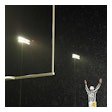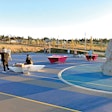![[Illustration by Arnel Reynon]](https://img.athleticbusiness.com/files/base/abmedia/all/image/2016/07/ab.Legal616_feat.png?auto=format%2Ccompress&q=70&w=400)
This article appeared in the June issue of Athletic Business. Athletic Business is a free magazine for professionals in the athletic, fitness and recreation industry. Click here to subscribe.
When building a sports or recreation facility, there are a million and one things that the new owners (perhaps a city) need to consider. One of the most important items on the list is access — getting people in and out of the facility. A sometimes-underappreciated aspect of a building access plan is parking.
Not all facilities require the same amount of parking. The number of spaces required is going to depend on the type of facility being built. A swimming pool, skating rink or recreation facility should plan on three spaces per 1,000 square feet of gross floor area. For a larger sports arena or stadium, the general rule is one space for every 10 seats.
While these guidelines may make it easy for the new facility owner to determine the number of parking spaces needed when building parking lots next to the facility, they do not account for the potential impact on people living next to the new facilities. A good example of the unintended problems that can result when such parking lots are built next to residential neighborhoods is John Perry et al. v. Town of Putnam, 131 A.3d 1284 (2016).
NUISANCE LAW
The Town of Putnam, Conn., built a parking lot on public land to provide access to some of the town's athletics facilities. The town built the new parking lot next to the facilities, but also adjacent to residential property. In challenging the town of Putnam's right to build the parking lot in the area, John Perry and Patricia Perry, homeowners whose property sits immediately adjacent to the parking lot, claimed that the lot was a nuisance and therefore should be removed.
In particular, John Perry alleged that unlawful activities had regularly occurred in the parking lot, including the overnight parking of trucks kept idling as their drivers slept inside, inappropriate sexual activity in parked motor vehicles, underage drinking, drug sales, overnight gatherings involving people playing loud music and engaging in boisterous behavior, littering of automotive parts, and headlights shining directly into their home.
In reviewing Perry's nuisance claim, the court found that Connecticut General Statutes § 52-557n (a) (1) (C) provides in relevant part: "Except as otherwise provided by law, a political subdivision of the state shall be liable for damages to a person or property caused by ... acts of the political subdivision which constitute the creation or participation in the creation of a nuisance... "
However, in order to show that the parking lot created a nuisance, the court ruled that Perry had to show the following four elements: 1) the condition complained of had a natural tendency to create danger and inflict injury on person or property; 2) the danger created was a continuing one; 3) the use of the land was unreasonable or unlawful; and 4) the existence of the nuisance was the proximate cause of the plaintiffs' injuries and damages.
In addition, when the alleged wrongful act was committed by a municipality, the court — citing Picco v. Voluntown, 295 Conn. 141 (2010) — held that the law also required Perry to prove that the town, by some positive act, created the condition constituting the nuisance.
In rejecting Perry's claim, the Appellate Court of Connecticut held that even assuming everything Perry said was true, he still failed to show a cause of action for nuisance. The court found that Perry failed to allege facts sufficient to support several of the elements of nuisance. In particular, the court held that Connecticut case law has never deemed a parking lot to have a natural tendency to create danger and to inflict injury. Conditions deemed to have such a tendency include a diving board positioned over very shallow, murky water without signage to indicate the danger, as illustrated in Hoffman v. Bristol, 113 Conn. 386, 387, 155 A. 499 (1931). Therefore, while the parking lot may have resulted in some unpleasant activities, such activities do not equate the parking lot with a natural tendency to create danger and to inflict injury.
More from AB: How to Keep Parking Lots Safe
THIRD-PARTY PROBLEM
Next, the court found that despite these resulting unpleasant activities, building a public parking lot on town land in the vicinity of athletics facilities is not an unreasonable use of the land, nor is it unlawful. To the contrary, building a public parking lot is a quintessential municipal function. In order for the parking lot to be functional, it must be in proximity to the facilities it is intended to serve, and it is common knowledge that parking lots regularly abut residential areas. Therefore, the court declined to hold that the placement of a parking lot on town property was unreasonable.
In addition to failing to establish the above two elements, the court also concluded that Perry could not establish that the town affirmatively acted to create the nuisance that caused the alleged injuries. In support of this finding, the court held that the plain meaning of law imposes liability in nuisance on a municipality only when the municipality positively acts (does something) to create (cause) the alleged nuisance.
In rejecting Perry's claim that the town's decision to locate, construct and encourage parking in the parking lot constituted the affirmative act required to plead nuisance against a municipality, the court found that the acts complained of did not create the alleged nuisance. In particular, the court noted that the unpleasant activities involved in this case are those of third parties.
Therefore, it is the activities that Perry claims now regularly occur in the parking lot, not the town's construction or location of the parking lot, that are the cause of Perry's problems. The remedy for such unpleasant and disruptive behavior by third parties, the court held, is with police regulation and control, not the law of nuisance.
More from AB: How to Keep Sports Venue Parking Lots Safe and Secure
PARK CAREFULLY
Although Perry was unable to show that the town created a nuisance by placing the parking lot for its athletics facilities adjacent to his residential property, the case still provides a couple of lessons for facility architects and city planners.
First, while all facilities need parking, architects and city planners — to save time and money while engendering good will — should consider the impact such construction projects have on existing residential areas.
Second, since recreational and school facilities are usually located in close proximity to the residential areas they are intended to serve, alternative locations may not be available. However, in those cases in which the facility and parking lots need to be constructed next to existing residential areas, the city needs to make sure to regularly and properly police the areas.
It is in the interest of no one — the tax-paying homeowner or the city — for the facility parking lot to be a base for the playing of loud music or, worse, assorted criminal activity that could spill over into the residential neighborhoods. This would only force the tax-paying homeowners to move out of the neighborhood, potentially causing a downward spiral on the town's tax base.
Attorney John Wolohan is a professor of sports law in the David B. Falk College for Sport and Human Dynamics at Syracuse University.
This article originally appeared in the June 2016 issue of Athletic Business with the title "Town’s siting of parking lot challenged by homeowner"
































